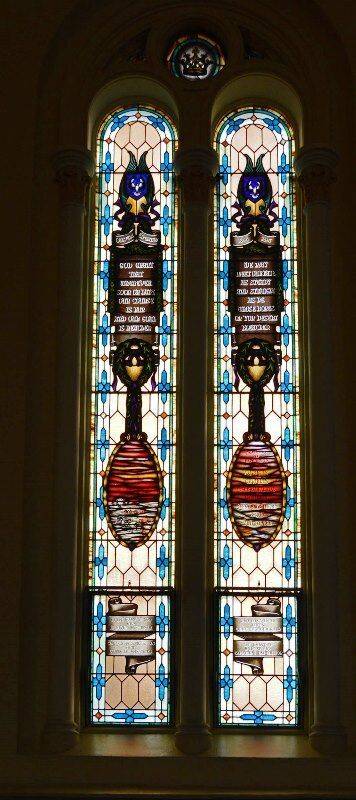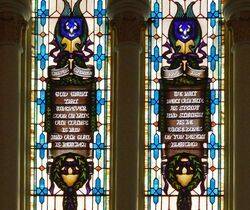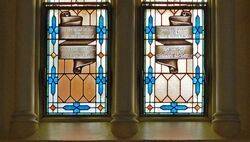
Charles Wells & George JonesPrint Page 
The stained glass window commemorates Charles Wells and George Jones, who died during the Calvert Expedition of 1896 and 1897.
The expedition was financed by Albert Frederick Calvert, a London based mining engineer, and conducted under the auspices of the South Australian Branch of the Royal Geographical Society of Australasia. Its main aim was to build on the achievements of the 1891 Elder Expedition in exploring a still largely unknown inland area of Western Australia, mainly in the Great Sandy Desert. Expedition personnel included Larry Wells (leader); Charles Wells (his cousin and the second in command); George Jones (mineralogist and photographer); George Keartland (naturalist); James Trainor; with Dervish Bejah and Said Ameer (camel drivers) and 20 camels.
The expedition departed Mullewa in Western Australia on 13 June 1896, heading north towards the Fitzroy River in the West Kimberley. By 21 July they had reached the limits of previously explored territory and known water supplies. In early August they were advancing into the Great Sandy Desert and having problems with the availability of water and with camels falling sick through the consumption of poisonous plants. In October Charles Wells and Jones left to make a side journey towards the north-west, intending to rejoin the others later. On 9 November the main party reached the track from Derby to the Fitzroy Crossing, and Quanbun Station on 13 November. Concern for the two missing members of the expedition led to a series of search parties, with the mummified bodies of Charles Wells and Jones, who had perished from extreme heat and lack of water, eventually being found on 27 May 1897. George Jones’ diary, found with his body, indicated that they had died on about 21 November 1896 while following in the tracks of the main party. The bodies were returned to Adelaide where a state funeral was held for them on 18 July 1897.
In the presence of survivors of the Calvert expedition of 1896 and relatives of the dead men, His Excellency the Governor (Sir Winston Dugan) unveiled a memorial window to C. F. Wells and G. L Jones at the Brougham Place Congregational Church yesterday morning. His Excellency said that he considered it an honor to unveil a memorial to two brave men. The president of the Royal Geographical Society (Mr. Newland, MP.) said that he knew what being without water meant, and he could appreciate what the dead men and those who had survived had done.
The Rev. L. C. Parkin, in his address, sketched in brief a history of the expedition and the trials it had gone through. He told how Mr. L. A. Wells, the leader, had made four journeys on the track taken by the two men who had died, and how they had been found six months later. Mr. Parkin also showed how Australia had benefited from the expedition. Among those who attended were Mr. L. A. Wells, the leader of the expedition, and Bejah Dervish, the camel-driver, who came from Marree to be present at the service.
The Advertiser (Adelaide), 28 June 1937.
Note: The Brougham Place Uniting Church was formerly the Congregational Church.
Location
| Address: | 193 Brougham Place , Brougham Place Uniting Church, North Adelaide, 5006 |
|---|---|
| State: | SA |
| Area: | AUS |
| GPS Coordinates: | Lat: -34.909463 Long: 138.600447 Note: GPS Coordinates are approximate. |
Details
| Monument Type: | Window |
|---|---|
| Monument Theme: | People |
| Sub-Theme: | Exploration |
Dedication
| Actual Monument Dedication Date: | Sunday 27th June, 1937 |
|---|
To the glory of God
And in loving memory of Charles Frederick Wells and George Lindsay Jones who lost their lives while engaged with the Calvert Scientific Exploring Expedition
































